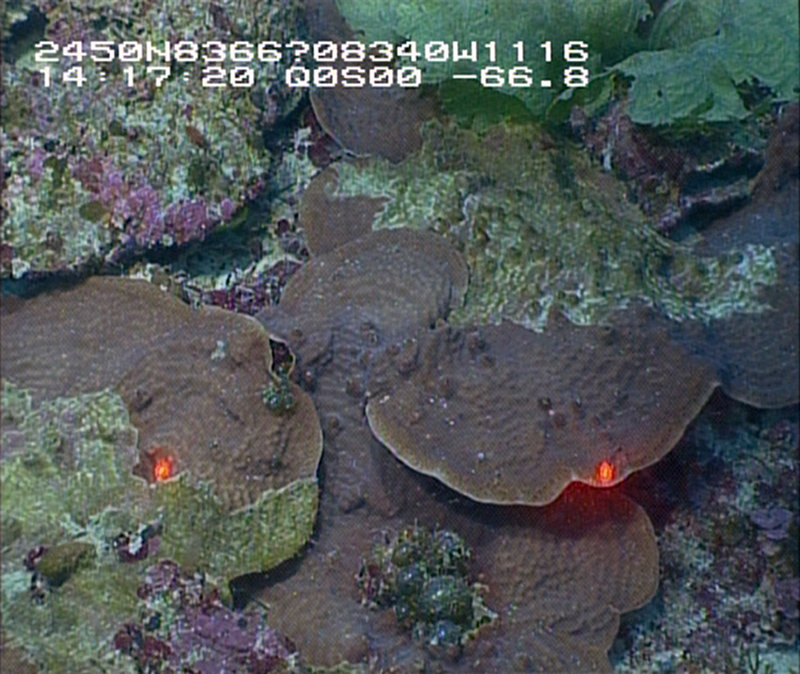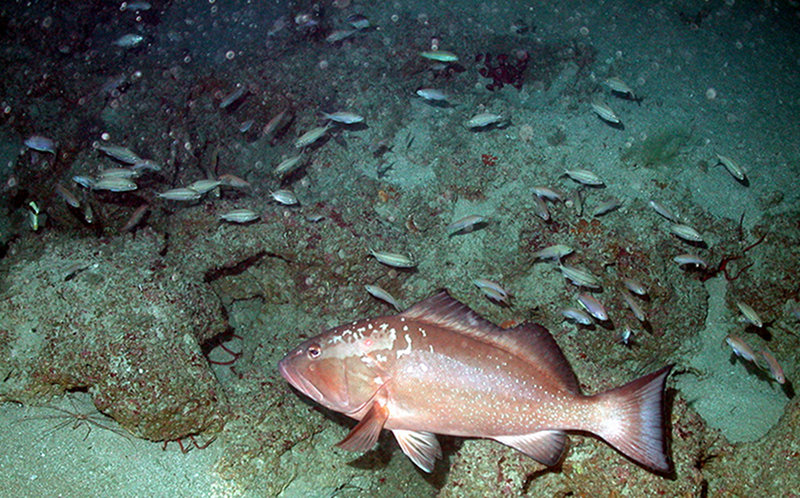
Robert Cowen, Ph.D., Director and Project Lead - Hatfield Marine Science Center, Oregon State University

Figure 1. The University of Miami’s technical dive team installing sensors on a mooring buoy to collect information on ocean currents. Image courtesy of Mike Echevarria, Florida Aquarium. Download larger version (jpg, 3.3 MB).
Mesophotic coral ecosystems are characterized by corals that live in relatively deep, low light environments (30 m-100 m). Once established, the corals help create hard bottom habitat that become home to a diverse community of plants and animals, many of which are unique to these communities, but other species are also found in shallower reef habitats. Understanding the factors that determine where mesophotic reefs are located, and distances over which species living within such environments disperse and therefore ‘connect’ populations are of great interest to marine scientists and resource managers alike. Despite this interest, the deep depths of such reefs have limited their discovery and exploration.
To address this knowledge gap, we designed an interdisciplinary study directed at determining the connectivity of reef species living in Pulley Ridge, the deepest known photosynthetic coral reef off the continental U.S., to those in the Florida Keys, as well as describing the structure and determining the economic value of Pulley Ridge’s mesophotic communities. Results from this study will then be packaged into a format that can be used by resource managers to manage and protect shallow and mesophotic coral ecosystems.
We have assembled a large team of experts from physical and biological oceanographers to population geneticists to resource economists to evaluate the processes driving these communities, their connectivity and their value as a resource. In all, the scientific team, includes 35 scientists from 11 different academic institutions and 3 federal and state agencies, working with federal, state, and non-governmental stakeholders to ensure that its scientific approach addresses resource manager needs.
To manage such a large group and draw upon their respective expertise, the project is compartmentalized into seven separate groups:
Each group works on a specific aspect of the study, and then results are shared and integrated among groups.
Four of the research groups are working to address the research objective focused on understanding population connectivity between Pulley Ridge and the Florida Keys. The Biological-Physical Modeling group is split into modelers and larval fish biologists. The modelers require: information on ocean currents from the Physical Oceanography group (Figure 1), biological data from the fish biologists within their own group, and information on adult fish growth and reproduction from the Population Dynamics group. These data are then used to develop a model to predict the degree of connectivity, which is then verified by information from the Population Genetics group. Although this may sound complicated, bringing scientists together from different disciplines is a good way to address complex problems.

Figure 2. A view of the screen image from a remotely operated vehicle (ROV) of plate corals, Agaricia sp., on Pulley Ridge at 68 m. The red dots are lasers from the ROV with a known distance that allow scientists to estimate the size of organisms. Image courtesy of John Reed using the University of Connecticut’s Kraken ROV. Download larger version (jpg, 256 KB).
To assess the community structure of mesophotic reefs, we rely on the Community Structure group for their diverse expertise with benthic organisms (corals, sponges, algae, invertebrates, fish) and with remote sampling tools (notably Remotely Operated Vehicles – ROVs), Figure 2. Additional information key to describing the full mesophotic community will be provided by the Population Dynamics group as they focus on adult fish such as groupers. The information from these two groups is then synthesized into GIS maps showing the distribution and abundance of benthic organisms across Pulley Ridge.

Figure 3. Understanding the value of the commercial fish species present at Pulley Ridge, such as the red grouper, Ephinephelus morio, is a key research objective for this project. Image courtesy of University of North Carolina at Wilmington. Download larger version (jpg, 1.0 MB).
The Bio-economics group will utilize information from the Community Structure group, as well as assimilate fisheries data (Figure 3), to evaluate the potential economic value of the different components of the mesophotic reef communities. They will do so not just from a fishery perspective, but also for tourism and ecosystem services (fundamental life-support processes upon which all organisms depend).
All information produced by the groups will be compiled by the Decision Support Tool group into a searchable database designed by and for resource managers. By combining all data and analyses stemming from the project groups into a usable format that can help resource managers use the best available science to make decisions, we will have provided a truly science-based tool for managing this critical and unique habitat.